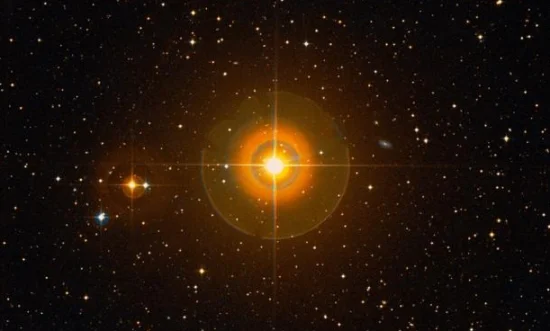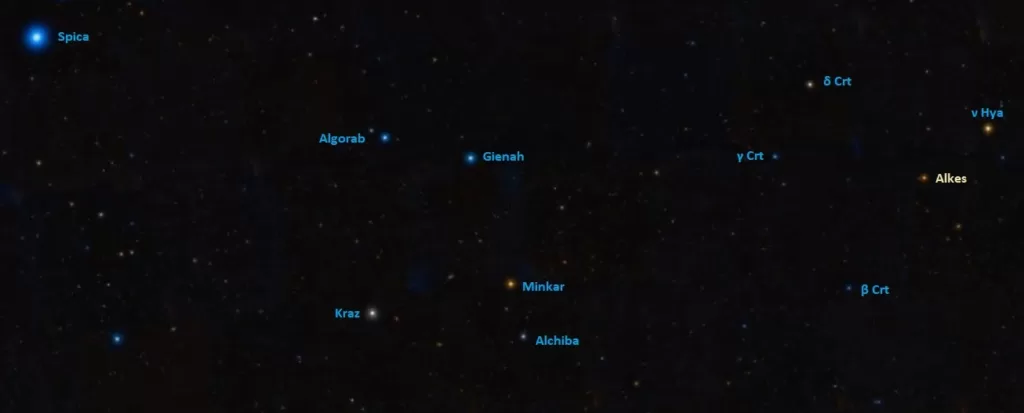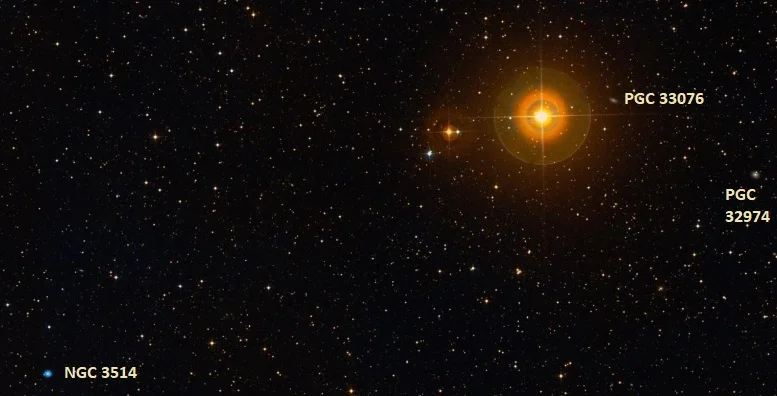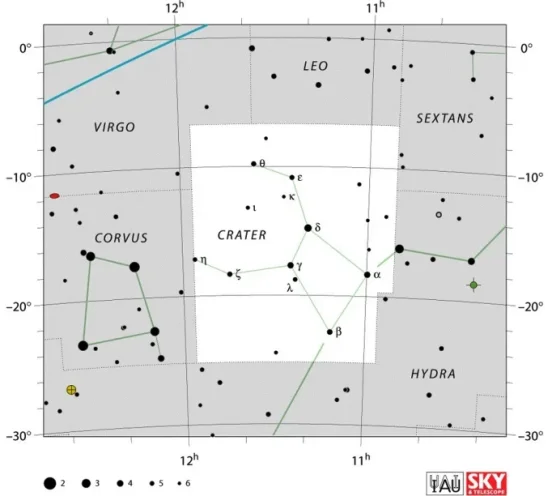Alkes, Alpha Crateris (α Crt), is an orange giant star located in the constellation Crater. With an apparent magnitude of 4.07, it is the third brightest star in Crater, after Delta and Gamma Crateris. Alkes lies at an approximate distance of 141 light years from Earth. It marks the base of the celestial Cup (Crater).
Star type
Alkes is an orange giant of the spectral type K1 III. It has a mass of 1.81 solar masses and a radius 12.32 times that of the Sun. With a surface temperature of 4,691 K, the star is 66 times more luminous than the Sun. Its estimated age is about 2.06 billion years.
Alkes is believed to be a horizontal branch star (a red clump giant), a star that has undergone a helium flash and is now fusing helium in its core and hydrogen in the surrounding shell. The horizontal branch is a phase of evolution that occurs just after the red giant branch in stars with masses similar to the Sun’s. Other stars at this stage include the bright Capella in Auriga, Ain in Taurus, and Diphda in Cetus.

Alkes (Alpha Crateris), image: Wikisky
It is also possible that Alkes is on the red giant branch (RGB), also known as the first giant branch. RGB stars are low-to-intermediate mass stars that have evolved away from the main sequence, but have not yet undergone helium ignition.
Name
The name Alkes (pronunciation: /ˈælkɛs/) comes from the Arabic alkās, meaning “the cup.” It is a reference to the constellation Crater, which represents the cup carried by Apollo’s crow.
Crater is associated with the story of the Greek god Apollo sending the crow to get water from a spring. The crow took the cup but, instead of bringing water right away, it was distracted by a fig tree with unripe fruit and waited a few days for the figs to ripen. After eating the figs, the crow went back to Apollo and blamed a water snake for its tardiness, saying that it had blocked the spring. Apollo was angered by the crow’s obvious lie and condemned the bird to a life of thirst. The story explains why crows have such a rasping call. In the myth, Apollo placed the crow, the cup and the water snake in the sky to commemorate the incident. The three are represented by the constellations Corvus, Crater, and Hydra. (Hydra is more commonly associated with the Lernean Hydra, a monster that was one of Heracles’ Twelve Labours.)
The name Alkes was approved for Alpha Crateris by the International Astronomical Union’s (IAU) Working Group on Star Names (WGSN) on September 12, 2016.
The 17th century Egyptian astronomer Al Achsasi al Mouakket listed Alkes as Aoul al Batjna, meaning “the first cup.” The name was later translated into Latin as Prima Crateris.
In Chinese astronomy, Alkes is known as 翼宿一 (Yì Sù yī), the First Star of Wings. The Chinese Wings asterism is formed by Alkes with Gamma Crateris, Zeta Crateris, Lambda Crateris, Nu Hydrae, Eta Crateris, Delta Crateris, Iota Crateris, Kappa Crateris, Epsilon Crateris, HD 95808, HD 93833, Theta Crateris, HD 102574, HD 100219, Beta Crateris, HD 99922, HD 100307, HD 96819, Chi1 Hydrae, HD 102620 and HD 103462. The Wings mansion is one of the southern mansions of the Vermilion Bird.
Location
Alkes is relatively easy to find because it lies in the same area of the sky as the bright Spica and the asterism known as Spica’s Spanker. Spica’s Spanker (or the Sail) is formed by the brightest stars in the neighbouring Corvus: Gienah, Kraz, Algorab, and Minkar. Spica is found along the imaginary curved line extended from the Big Dipper’s handle. Arcturus is the first bright star on the line and Spica is the second. Spica’s Spanker lies southeast of Spica.

Alkes location, image: Wikisky
The constellation Crater is dominated by a rectangle pattern formed by Alkes with Beta, Gamma, and Delta Crateris. The asterism lies just west of Spica’s Spanker. Alkes is the westernmost star in the rectangle, or the one the furthest away from Spica’s Spanker.
Several faint galaxies lie in the vicinity of the star: the spiral galaxies NGC 3514 and PGC 33076, and the barred spiral PGC 32974.

Alkes, NGC 3514, PGC 33076 and PGC 32974, image: Wikisky
Constellation
Alkes is located in the constellation Crater, the Cup. Crater lies in the southern sky. It is one of the smaller constellations, occupying an area of 282 square degrees between Virgo, Corvus, Hydra, Sextans and Leo. It represents the cup held by the crow (Corvus) sent by the god Apollo to fetch him some water. Crater is one of the 48 Greek constellations, catalogued by the Greek astronomer Ptolemy in his Almagest in the 2nd century CE.

Crater constellation map by IAU and Sky&Telescope magazine
Crater is too faint to be visible from heavily light-polluted areas, with no stars brighter than magnitude 3.00. The constellation’s brightest star, the orange giant Delta Crateris, shines at magnitude 3.56. Other notable stars in the constellation include the BY Draconis variable SZ Crateris, the cataclysmic variable TT Crateris, and the semiregular variable R Crateris.
Deep sky objects in Crater include the Crater 2 dwarf, a satellite galaxy of the Milky Way, the spiral galaxies NGC 3511 and NGC 3981, and the barred spiral galaxy NGC 3513.
The best time of year to watch the stars and deep sky objects in Crater is during the month of April, when the constellation climbs high above the horizon in the evening sky. The entire constellation is visible from locations between the latitudes 65° N and 90° S.
The 10 brightest stars in Crater are Delta Crateris (mag. 3.56), Gamma Crateris (mag. 4.06), Alkes (Alpha Crt, mag. 4.07), Beta Crateris (mag. 4.46), Theta Crateris (mag. 4.70), Zeta Crateris (mag. 4.740), Epsilon Crateris (mag. 4.84), Lambda Crateris (mag. 5.08), Eta Crateris (mag. 5.17), and Iota Crateris (mag. 5.48).
Alkes – Alpha Crateris
| Spectral class | K1 III |
| Apparent magnitude | 4.07 |
| Absolute magnitude | +0.44 |
| Distance | 141 ± 2 light years (43.2 ± 0.7 parsecs) |
| Parallax | 23.1349 ± 0.3685 mas |
| Radial velocity | 47.54 ± 0.16 km/s |
| Proper motion | RA: −462.26 ± 0.24 mas/yr |
| Dec.: 129.49 ± 0.26 mas/yr | |
| Mass | 1.81 M☉ |
| Luminosity | 66.0 L☉ |
| Radius | 12.32 R☉ |
| Temperature | 4,691 K |
| Metallicity | +0.01 dex |
| Age | 2.06 billion years |
| Surface gravity | 2.53 cgs |
| Constellation | Crater |
| Right ascension | 10h 59m 46.4648602s |
| Declination | −18° 17′ 55.617244″ |
| Names and designations | Alkes, Alpha Crateris, α Crt, 7 Crateris, HD 95272, HR 4287, HIP 53740, FK5 1283, SAO 156375, BD-17° 3273, LTT 4040, NLTT 25942, PPM 223763, GC 15106, GCRV 6795, JP11 2016, IRAS 10573-1801, 2MASS J10594651-1817560, PLX 2562.00, UBV 10058, TYC 6079-1901-1, Gaia DR2 3553136288323783680 |